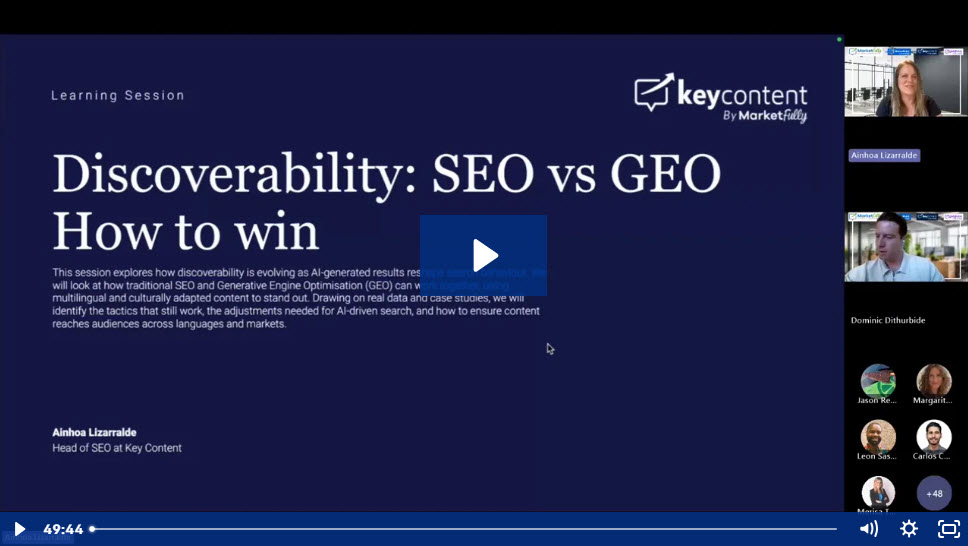Why multilingual content marketing?
When it comes to multilingual content marketing, translating existing assets word for word isn’t enough. You’ll need a strategic discipline that aligns language, culture, and business intent across markets. Every step must be planned and executed with an understanding on the regional mind, from research and creation to technical SEO and performance tracking.
The sections below cover the core pillars of multilingual content strategy that are built on practical insights from real international campaigns.
Choosing the right approach: translation, transcreation, or original content
The foundation of any multilingual content strategy is choosing the right method of content creation, and understanding that each market has different expectations, levels of familiarity with your product, and cultural filters that shape how they interpret the messaging.
While translation includes technical accuracy and consistency, it doesn’t often address emotional tone or user intent. Transcreation takes it a step further, reshaping messaging, imagery, and structure to suit regional sensitivities. Original content creation is needed in some cases, especially when search intent, consumer trends, or formats differ significantly across markets. The right approach for your business depends on the purpose of the content and the expectations of your local audience.
Based on the type of content and goal:
• Use translation for manuals, legal pages, product specs or regulated financial content
• Use transcreation for brand campaigns, taglines, hero banners or email nurturing
• Use original content for blog posts, country-specific guides, or where local search intent demands unique coverage
Embedding E-E-A-T across languages
Once the content type is defined, the next step is making sure it earns trust. Google’s E-E-A-T framework (Experience, Expertise, Authority, and Trustworthiness) is applied across the globe, and multilingual content must meet these expectations in every market if it is to succeed.
This involves including things like real examples, subject matter expertise, certifications, and local citations. Trust-building is about what is being said, as well as how it is being said. In some markets, transparency comes from customer stories and directness. In others, users expect data, credentials and regional awards. To build authority across languages, content must be culturally aligned and must show reliability.
E-E-A-T elements to integrate:
• Firsthand experiences (e.g. testimonials or local case studies)
• Input from subject matter experts (SMEs) to validate and make sure of accuracy
• Evidence of authority like awards, accreditations, or known publications
• Clear signals of trust (e.g. transparent sources, HTTPS, contact info)
Understanding regional search intent and behaviour
Search intent isn’t something that’s universal, because what users look for, how they phrase it, and what format they expect varies tremendously by region. Informational, transactional, and navigational queries exist everywhere, but the language and context behind them change.
For instance, health-related content in one market may prioritise scientific backing, while another market prefers to use lived experience. A keyword that performs in one language might have a low search volume or a completely different meaning in another.
Multilingual content strategy must be rooted in local search trends, seasonal spikes, and cultural nuance to make sure that each piece of content serves real user needs.
Considerations when researching local intent:
• Informational, transactional and navigational terms vary by language and dialect
• Language-specific variants (e.g. “diapers” in US English vs. “nappies” in UK English)
• Local economic context or priorities (e.g. sustainability, value for money, innovation)
• Seasonal search spikes using tools like Google Trends
Planning with purpose: strategy, personas, and messaging
Developing a multilingual strategy begins with market research and a clear goal per region. Using the SMART framework (Specific, Measurable, Achievable, Relevant, Time-bound) helps keep your multilingual effort in lines with your business outcomes.
Effective planning includes setting KPIs per language, building buyer personas that reflect local behaviours, and shaping adaptable brand messaging. Personas should detail language preferences, pain points, content formats, and tone expectations. Core messages should stay consistent, but their delivery (tone, emotional appeal, level of detail) must be tailored to resonate locally.
Components of a multilingual persona:
• Local demographics and psychographics (e.g. lifestyle, values, aspirations)
• Language and content preferences (e.g. formal vs. conversational tone)
• Buying motivations and barriers in that region
• Decision-making behaviour and content consumption habits
• Trusted sources (e.g. social platforms, media channels, influencers)
Governing tone and quality at scale
As the footprint of your content grows, it becomes more and more critical to govern it properly. Brand consistency and quality depend on well-documented rules and shared frameworks that make local variation easier, but also keeps your overall brand identity intact.
A multilingual style guide will help keep your grammar, punctuation, terminology, tone of voice, and formatting consistent, while also leaving space for local adaptation, whether through idiomatic expression, regulatory references, or cultural sensitivities.
Market-specific content templates, flexible briefs, and clear editorial processes are a great way to make sure quality is maintained across languages, even at scale.
Core style guide elements to include:
• Tone of voice rules (formal, friendly, technical, emotive) per market
• Grammar and spelling conventions (regional or simplified variants)
• Terminology and glossary for product-specific terms
• Cultural red flags: idioms to avoid, symbols, humour
• Formatting preferences for bullet lists, numbering, punctuation, etc.
SEO optimisation for multilingual visibility
Even high-quality content will fail if it doesn’t have search visibility. Multilingual SEO requires more than just keyword translation. It demands local keyword research, market-specific metadata, SERP analysis, and technical infrastructure that supports regional targeting.
Some of the critical components include hreflang implementation, localised URL structures, canonicalisation to prevent duplication, and understanding which SERP features matter most in each country. Keyword clustering and internal linking should reflect regional content priorities, not just global logic.
Elements to prioritise in multilingual SEO:
• Keyword research per region with volume and intent analysis
• On-page elements adapted per language (metadata, headings, alt text)
• Proper hreflang and canonical tags for search engine clarity
• Regional URL strategies and sitemap submissions
• Internal linking based on topic clusters relevant per market
Performance tracking by market
Visibility and impact must be measured per market. Global dashboards are helpful, but real insights come from regional segmentation. Google Search Console, GA4, Semrush and Screaming Frog can be configured to provide country-level views, tracking impressions, CTRs, conversions and technical health across language versions.
Unified dashboards can help teams identify which content drives the most value and where to iterate. Using UX tools like Hotjar or Crazy Egg can also highlight behavioural trends like navigation preferences or layout responses that differ from one country to another.
Suggested setup for performance tracking:
• GA4 property views by language or domain (e.g. site.fr, site.de)
• Localised rank tracking with alerts per keyword group
• Screaming Frog to monitor hreflang, canonical and duplicate tags
• Behavioural heatmaps segmented by region
Identifying content gaps with regional context
Tracking performance is one of the best ways to show you where opportunities lie. Content gap analysis is especially valuable in multilingual campaigns, and highlights where competitors have a strong local presence or where user needs are not being met.
These gaps might relate to format, thoroughness, tone or even channel. For example, some markets may prefer visual content, while others rank listicles higher. A structured gap analysis will help you prioritise new assets and updates based on local search demand and competitive positioning.
Common types of multilingual content gaps:
• Outdated or thin content that misses regional updates or trends
• Missing subtopics or related queries that competitors rank for
• Weak SERP alignment (e.g. content doesn’t match listicle or video format)
• Lack of expert sources or missing localisation elements
• Overlap of translated content without regional nuance
Bringing it all together
Multilingual content marketing only works when each component is built with localisation in mind, from research and planning to SEO and reporting. Your strategy must define what the content needs to achieve in each region. The creation of the content must reflect tone and search intent, and the measurement must be granular enough to highlight regional trends and opportunities.
By aligning every stage to the user’s language, behaviour, and expectations, businesses can build international visibility, local trust and scalable performance.

